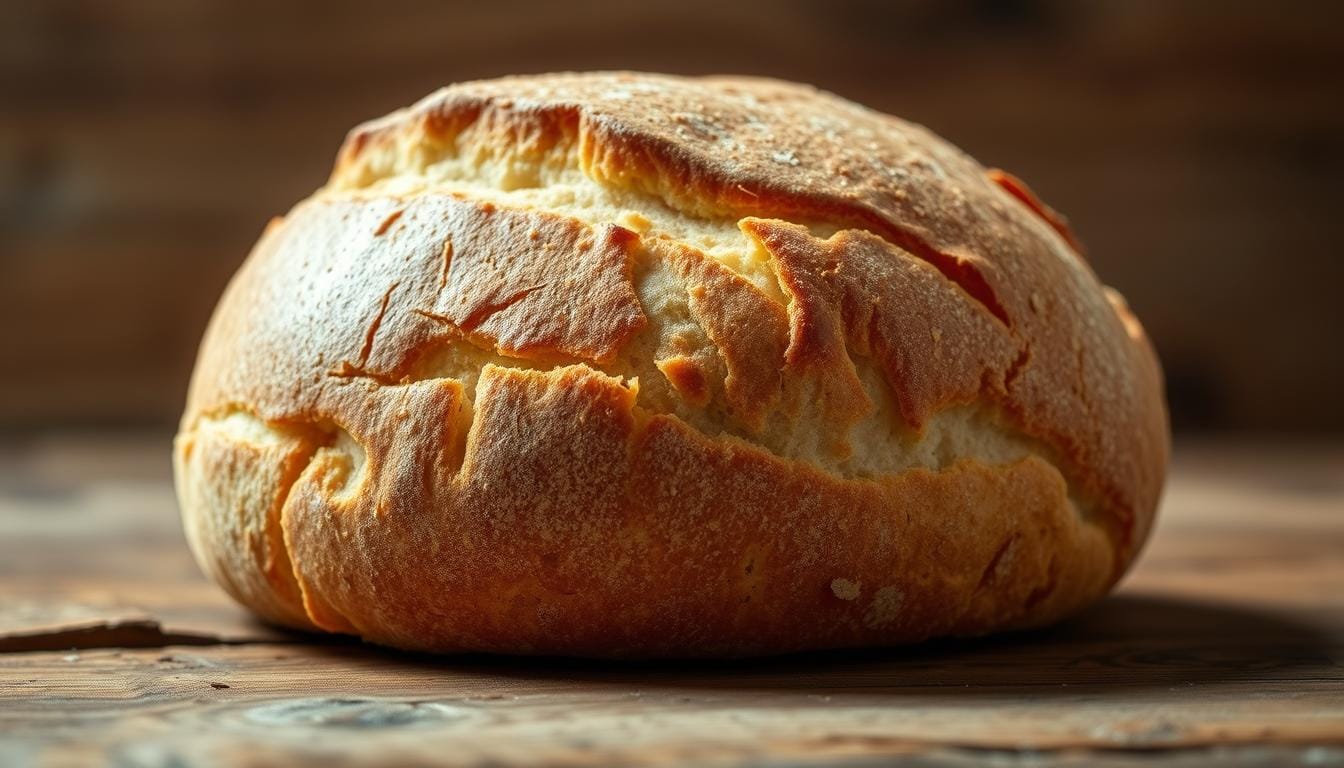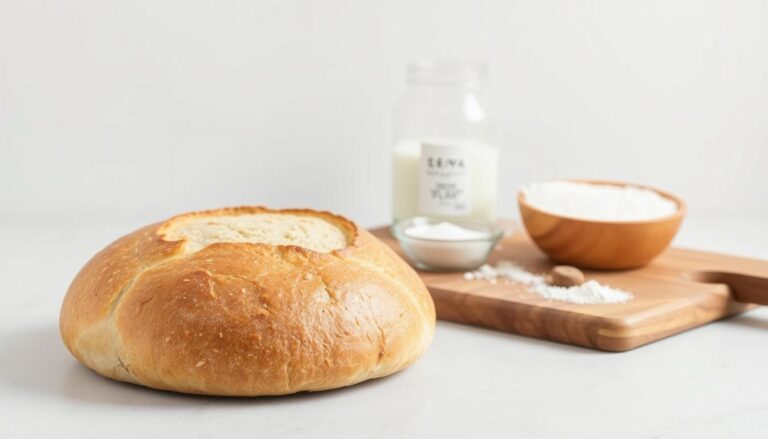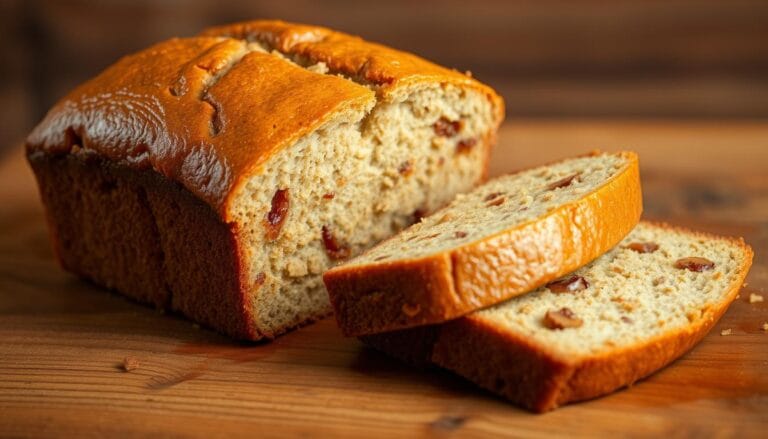Sourdough Sandwich Bread Recipe – Master Version
The first time I pulled a golden, crusty loaf from my oven, I felt magic. My kitchen smelled like my grandmother’s bakery. It was a place where bread was a craft, connecting us to our past.
Making sourdough bread is more than a recipe. It’s about the mix of flour, water, and living cultures. This recipe will help you make a soft, tasty loaf for your sandwiches.
This recipe is for everyone, from new bakers to sourdough experts. It makes a bread that’s always delicious. Each slice is a story of patience, skill, and fermentation’s magic.
Start your baking journey now. Your kitchen will become a place of warmth, flavor, and tradition.
Table of Contents
Essential Ingredients for Perfect Sourdough Sandwich Bread
Making sourdough bread is easy with the right ingredients. You need to pick the best ones for a tasty sandwich loaf. Start your journey to making sourdough at home by choosing the right ingredients.
Understanding Sourdough Starter Requirements
Your sourdough starter is key to making great bread. For a simple recipe, use a starter that’s active and bubbly. A good starter doubles in size in 4-8 hours after feeding.
- Consistency: Thick and pudding-like
- Activity: Doubles in volume
- Smell: Pleasantly tangy and yeasty
Flour Selection and Quality Considerations
Picking the right flour is important for your bread. High-protein bread flour makes your sandwich bread chewy and great. Look for flour with 12-14% protein for the best results.
“The quality of your flour determines the soul of your bread” – Artisan Baker’s Wisdom
Additional Ingredients and Their Purpose
Some extra ingredients can make your bread even better. Salt adds flavor and makes the dough stronger. Honey or milk powder can make your bread softer and more complex.
| Ingredient | Purpose | Quantity |
|---|---|---|
| Bread Flour | Provides structure | 500g |
| Water | Hydrates flour | 350g |
| Salt | Enhances flavor | 7g |
Required Equipment and Tools
Baking sourdough bread is more than just mixing ingredients. The right tools make it fun and easy. Having the right equipment helps you make bread that tastes like it came from a bakery.
Here are the must-haves for baking sourdough bread:
- Digital Kitchen Scale: This tool is key for precise measurements. It helps you get the ingredients just right.
- Large Mixing Bowl: Pick a big bowl (about 23cm diameter, 9cm deep). It’s needed for mixing the dough well.
- Bowl Scraper: This tool helps with sticky dough. It makes sure you get all the ingredients mixed in.
- Pullman Loaf Pan: This special pan (21.5 x 12.5 x 11.5 cm) makes your bread look perfect every time.
Some extra tools can make baking even better. A clean shower cap is great for covering your dough. It keeps it warm and safe from cold air.
Invest in good tools for your baking adventures. Each tool is important for making delicious sourdough bread at home.
Making the Overnight Levain
Learning to make sourdough bread starts with the overnight levain. This step turns simple ingredients into a living mix. It gives your bread its special flavor and rise.
Creating a perfect levain needs precision and knowing about fermentation. Your path to making great sourdough bread begins with the right ingredients and patience.
Mixing the Levain Components
When making sourdough bread, your levain ingredients are key. You’ll need:
- 1 cup plus 1 tablespoon bread flour (128g)
- 1/2 cup plus 1 tablespoon water (128g)
- 3 tablespoons ripe sourdough starter (44g)
Fermentation Time and Temperature
The magic of levain happens during fermentation. Keep the room temperature between 65°F and 75°F. This helps your levain grow complex flavors and strong fermentation.
Signs of Levain Readiness
Your levain is ready when it shows these signs:
- Bubbly surface with active fermentation
- Slightly domed appearance
- Pleasant, tangy aroma
- Doubled in volume
Patience is key when making sourdough bread. Your levain usually takes about 12 hours to be at its best. It changes from a simple mix to a vibrant, living part of your bread.
Preparing Your Sourdough Sandwich Bread Dough
Making sourdough sandwich bread dough needs care and precision. Start by getting all the right ingredients. Each one plays a part in making your bread tasty.
Here’s what you’ll need for your sourdough bread machine recipe:
- 5 1/4 cups (630g) bread flour
- 1 1/2 cups (340g) warm water
- 4 tablespoons (57g) unsalted butter
- 1/4 cup (50g) granulated sugar
- 6 tablespoons (42g) dry milk
- 2 1/2 teaspoons (15g) salt
- 2 teaspoons instant yeast
- All of your ripe levain
There are ways to mix your dough. You can use a stand mixer, knead by hand, or your bread machine. The goal is to get a dough that’s smooth and soft.
| Mixing Method | Pros | Considerations |
|---|---|---|
| Stand Mixer | Consistent mixing | Requires monitoring |
| Hand Kneading | Traditional approach | More physical effort |
| Bread Machine | Convenient | May need manual adjustments |
Watch how your dough feels. It should be soft but not too wet. If it’s too dry, add a little water. If it’s too wet, add flour a bit at a time.
Mastering the Folding and Stretching Technique
Learning to make sourdough bread means mastering folding and stretching. This turns your dough into a strong, textured loaf.
The folding technique is key for sourdough sandwich bread. It builds a strong, elastic dough. This dough is what makes your loaf great.
Proper Folding Methods
To make sourdough bread, follow these folding steps:
- Wet your hands to prevent sticking
- Gently lift the dough from one side
- Stretch it slightly without tearing
- Fold the stretched portion over the center
- Rotate the bowl and repeat on all sides
Timing Between Folds
Timing is important with sourdough. Here’s when to fold:
- First fold: After 2 hours of initial resting
- Second fold: 1 hour after the first fold
- Allow 30-60 minutes rest between each folding session
Developing Dough Structure
Each fold has a purpose in sourdough bread. The gentle stretching aligns gluten proteins. This creates a network that traps gas, giving sourdough its open crumb texture.
Remember, patience and gentle handling are key. Your dough will change from a shaggy mix to a smooth, elastic mass. It’s ready for proofing.
Proofing and Shaping Your Loaf

Mastering proofing is key for a great sourdough bread. It makes your bread light and fluffy. Knowing how to proof and shape is important.
Watch for signs that your dough is ready. Look for these:
- Noticeable increase in volume
- Bubbles forming on the surface
- Soft, puffy texture when gently touched
- Dough that springs back slowly when pressed
Keep the temperature between 70-75°F for proofing. Cooler temps slow it down. Warmer speeds it up. Use a clear container to track your dough’s growth and ensure you’re achieving the desired volume.
Shaping needs gentle hands. Turn the dough onto a lightly floured surface. Stretch and fold it to create tension. This helps it rise beautifully.
Pro tip: Cold hands can help prevent sticking when shaping your dough!
For the final proof, put your dough in a bread pan. Let it rise until it’s just above the pan’s edges. This takes 4-6 hours, depending on your kitchen’s temperature and humidity.
Your patience will pay off. You’ll get a light, airy sourdough bread. It’s perfect for sandwiches and toast.
Baking Temperature and Timing Guidelines
Baking sourdough bread needs careful attention to temperature and timing. The final steps can make or break your perfect loaf. Knowing the right techniques will help you get a golden crust and a perfectly cooked inside.

Your baking success depends on mastering two key things: preheating and creating the ideal baking environment for your sourdough sandwich bread.
Preheating Methods for Optimal Results
When baking sourdough bread, you have two main preheating ways:
- Fan-assisted oven: Preheat to 180°C (360°F)
- Non-fan oven: Preheat to 200°C (400°F)
Baking Stages and Crust Development
The baking process for sourdough sandwich bread has several key stages:
- Initial Spring: The first 10-15 minutes where bread rises fast
- Crust Formation: Getting a golden-brown outside
- Internal Cooking: Making sure the bread is fully cooked
Your total baking time will be between 45-55 minutes. Check your bread’s internal temperature, which should be around 96-98°C (205-208°F) for perfect doneness.
Pro tip: Use a digital thermometer to accurately gauge your bread’s internal temperature during baking.
Cooling and Storage Tips
Making the best sourdough sandwich bread is just the start. The cooling and storage steps are key to keeping the bread’s great taste and texture.
Once your sourdough sandwich bread is done baking, be patient. Let it cool down completely before you slice it. This step is important. It helps the bread’s inside set right, so it has a perfect crumb and doesn’t feel soggy.
- Take the sourdough sandwich bread out of the pan right after baking
- Put it on a wire rack to cool for at least 1-2 hours
- Don’t cut into the bread while it’s still warm
To store your bread well, wrap it in a clean cotton cloth or a paper bag. Don’t use plastic bags, as they can make the crust soft. At room temperature, your bread will stay fresh for 2-3 days.
Pro tip: Freezing is a great way to keep your sourdough sandwich bread fresh longer. Slice the bread before freezing, so you can thaw just what you need.
- Wrap it tightly in plastic wrap
- Put it in a freezer-safe bag
- Freeze for up to 3 months
To make day-old bread taste fresh again, sprinkle it with water and warm it in the oven. Set the oven to 350°F for 5-10 minutes. This will make the crust crispy again and your sourdough sandwich bread will taste like it just came out of the oven.
Troubleshooting Common Issues
Learning to make sourdough bread comes with challenges. It takes patience, practice, and knowing how to fix common problems.
Even skilled bakers face issues sometimes. The trick is to quickly spot and solve these problems.
Addressing Texture Problems
Texture is key for a great sourdough sandwich bread. Here are some common texture issues:
- Dense Bread: Often caused by underproofed dough or not enough gluten
- Gummy Crumb: Usually from underbaking or too much water
- Dry Loaf: Often means overbaking or too little fat
Fixing Rising Issues
Right rising is key for sourdough bread. Watch for these signs:
- Flat loaves mean weak starter or cold place
- Overproofed dough loses shape and feels slack
- Uneven rising shows starter or temperature issues
Resolving Baking Challenges
Baking sourdough needs precision and knowing your oven. Look out for:
- Uneven browning
- Underbaked centers
- Burnt crusts
“The secret to great sourdough is understanding your dough’s language.” – Professional Baker
With practice and careful watching, you’ll make delicious sourdough. It will wow your family and friends.
Conclusion
Making the perfect sourdough sandwich bread is a fun journey. Your easy sourdough bread recipe gets better with each loaf. This guide will make your home baking better, helping you make delicious bread every time.
Practice is key to getting good at sourdough baking. You’ll learn about starter care, folding, and baking temperatures as you go. Don’t worry if it’s not perfect at first. Each loaf teaches you something new.
Try different flours, water amounts, and ingredients to make your bread special. Baking is both science and art. Your unique touch will make your bread stand out and impress everyone.
Being patient and persistent is important in making sourdough bread. Enjoy the journey, trust yourself, and feel proud when you bake a perfect loaf.
FAQ
How long does it take to make sourdough sandwich bread?
It takes 24-36 hours to make sourdough sandwich bread. This includes starter prep, dough fermentation, and baking. You only need a few hours of hands-on time.
Can I use all-purpose flour instead of bread flour?
You can use all-purpose flour, but bread flour is better. Bread flour makes the bread chewier and more structured. All-purpose flour might make the bread less robust.
How do I know if my sourdough starter is active enough?
A good starter doubles or triples in 4-8 hours after feeding. It smells tangy and has lots of bubbles. It should float in water, showing it’s ready.
Can I make sourdough sandwich bread without a bread machine?
Yes! You can make it by hand or with a stand mixer. A bread machine helps mix, but isn’t needed. The key is to fold and stretch the dough well.
How long will homemade sourdough sandwich bread stay fresh?
It stays fresh for 3-5 days in an airtight container. You can freeze it for up to 3 months. Just thaw a slice as you need it.
Why did my sourdough bread turn out dense and heavy?
It might be under-proofed, have an inactive starter, or not enough gluten. Make sure your starter is active and give it enough time to ferment and proof.
Can I add seeds or other mix-ins to this sourdough sandwich bread?
Yes! Add seeds, nuts, or herbs during the final mix. But don’t add too much, as it can mess with the bread’s structure.
Do I need a special pan to make sourdough sandwich bread?
A Pullman loaf pan is best for a classic shape. But a standard loaf pan works too. Choose a pan with high sides for a uniform shape.
How important is weighing ingredients for sourdough bread?
Weighing ingredients is key for consistent bread. Volume measurements can vary. A digital kitchen scale is a good investment for sourdough.
Can I make this recipe gluten-free?
Making sourdough gluten-free is hard. Gluten-free flours can make the bread different. Gluten is important for the bread’s structure and texture.







